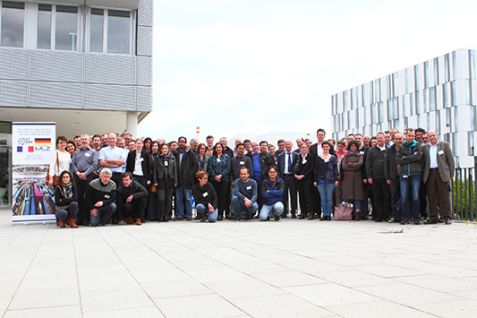MLZ is a cooperation between:
 > Technische Universität München
> Technische Universität München > Helmholtz-Zentrum Hereon
> Helmholtz-Zentrum Hereon
 > Forschungszentrum Jülich
> Forschungszentrum Jülich
MLZ is a member of:
 > LENS
> LENS > ERF-AISBL
> ERF-AISBL
MLZ on social media:

MLZ (eng)
Lichtenbergstr.1
85748 Garching
German-French workshop: How will Europe maintain its pole position in neutron science?

Participants of the German French Workshop of MLZ and 2DFN in front of the Institut of Advanced Studies in Garching © Björn Pedersen
Scientists of the MLZ and the 2DFN (La Fédération Française de la Diffusion Neutronique) discussed the opportunities of an enhanced cooperation among German and French neutron scientists during the workshop at the research campus in Garching. Europe is leading neutron science due to the Institute Laue-Langevin (ILL), the future European Spallation Source (ESS), and a network of powerful national sources like the MLZ. However, the closure of the two national neutron sources (Orphée in France and BER II in Germany) together with the increasing competition from Asia will lead to a change in the European neutron landscape.
Neutrons for science
Neutron research is indispensable when it comes to competition to solve the major challenges of today’s industrial societies. Neutrons guide us to more efficient energy storage, low-loss circuits of high fluxes and voltages, sustainable mobility, lightweight and long-lived motors as well as better data storage. Finally, neutron sources are the backbone for generating radioisotopes that are used for medicine.
The role of the MLZ
The MLZ is a cooperation between the Technical University of Munich (TUM), the Forschungszentrum Jülich, and the Helmholtz-Zentrum Geestracht for Materials and Coastal Research (HZG), the Max Planck Society, and nine university groups. The MLZ offers the scientific use of the Research Neutron Source Heinz Maier-Leibnitz (FRM II) to 1000 national and international research groups per year. Considering its 30 cutting-edge instruments as well as its high neutron flux, the FRM II is Europe’s most modern research reactor. Already, the demand for beamtime at the MLZ is twice as high as the available capacity. The decommissioning of Orphée and BER II in 2019 as well as of several smaller European research reactors in the upcoming years will increase the future demand at the MLZ drastically. Enhanced cooperation among the national neutron centers is the silver bullet to capacity expansion and, thus, strengthens European neutron science. “As of 2020, the MLZ will be the German center for neutron science. Towards the end of the decade, it will provide the greatest research capacity with neutrons in Europe”, says the director of the MLZ, Prof. Dr. Peter Müller-Buschbaum, “The MLZ also fulfils a European service as 55 percent of our users are international.”
German-French co-operation – now and then
The German-French neutron community can already look back on a joint success story. It started with the foundation of the ILL, which was followed by the membership in the League of Advanced European Neutron Science (LENS), numerous shared publications, the corporate construction of four insutrments at the ESS in Lund, and the high numbers of French users at the MLZ. However, the changing neutron landscape demands for an even stronger German-French cooperation, which was extensively discussed at the workshop. The MLZ hopes for assistance to provide more sophisticated and innovative instrumentation and is looking forward to exploring new fields of neutron science. The 2DFN hopes for support regarding the education of France’s prospective neutron scientists. “Until now, young scientists were trained at our national source, Orphée”, explains Virginie Simonet, the director of the 2DFN, “With the closure of this research reactor, we lose our education program and risk losing knowledge in neutron science.” The MLZ for its part supports over 200 PhD students per year, offers practical courses and lectures at the TUM and at its partner universities, and promotes the establishment of an international doctoral program. In particular, young French neutron scientists would profit from a cooperation with the MLZ; especially until the full operation of the ESS.
Simonet and Müller-Buschbaum agreed that research reactors like FRM II or ILL will not lose their importance beyond the commissioning of the ESS. On the contrary: the two directors emphasized that although the ESS would provide new measuring qualities, it will not contribute much to the measuring capacity. So, there will be a high competition for access to the ESS. The national sources will enable scientists to remain competitive. “We should not feel constrained by new neutron sources like the ESS. We should see them as an impulse for new ideas!”, Müller-Buschbaum concludes the workshop.
MLZ is a cooperation between:
 > Technische Universität München
> Technische Universität München > Helmholtz-Zentrum Hereon
> Helmholtz-Zentrum Hereon
 > Forschungszentrum Jülich
> Forschungszentrum Jülich
MLZ is a member of:
 > LENS
> LENS > ERF-AISBL
> ERF-AISBL
MLZ on social media:


